Mad Hedge Biotech and Healthcare Letter
March 20, 2025
Fiat Lux
Featured Trade:
(EVEN A PIG COULD MAKE MONEY HERE)
(OGN), (MRK), (RHHBY), (BAYRY), (PFE), (AZN)
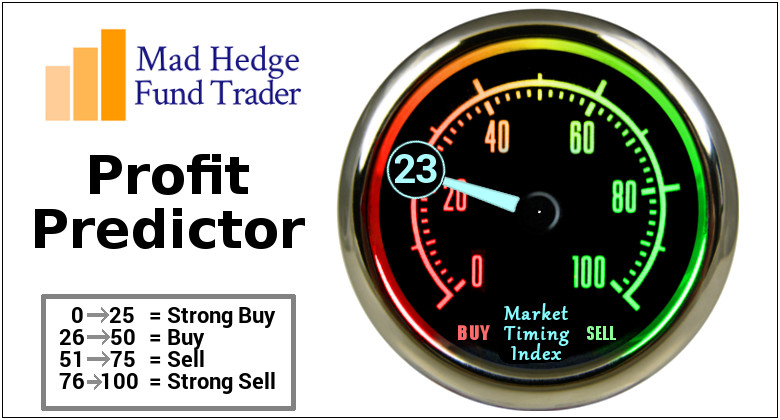
Mad Hedge Biotech and Healthcare Letter
March 20, 2025
Fiat Lux
Featured Trade:
(EVEN A PIG COULD MAKE MONEY HERE)
(OGN), (MRK), (RHHBY), (BAYRY), (PFE), (AZN)

I was camped out in Kyiv the other month when news of Organon's (OGN) earnings hit my phone.
While Russian drones buzzed overhead, I was studying pharmaceutical balance sheets—talk about surreal. Did I mention I've led a strange life?
In mid-February, Organon pleasantly surprised me with Q4 2024 results. Hadlima, their biosimilar to Humira, rocketed to $44 million in quarterly sales, up 83.3% year-on-year.
Meanwhile, Organon's dividend yield sits at a whopping 7.32%, blowing away the healthcare sector average.
Let me be blunt: this is an income investor's dream hiding in plain sight.
Organon emerged in 2021 when Merck (MRK) spun off its women's health, biosimilars, and off-patent drugs businesses. This allowed Merck to focus on its immunology and oncology pipeline while Organon became a pure-play commercial entity.
These spinoffs often create enormous value that the market misses in the early years.
Organon's share price has been trading sideways since early 2025 despite several wins: commercializing Hadlima, acquiring Dermavant, and maintaining a 23% operating margin even as some medications face generic competition.
The market clearly isn't paying attention. When stocks with this kind of dividend yield maintain solid margins, my antennae start twitching.
Their recent Phase 3 ADORING 3 study showed that even 79.8 days after stopping Vtama treatment, atopic dermatitis remained mild. That's patient retention gold, folks.
When patients can stop medication and still see benefits almost three months later, that's the kind of sticky customer base pharmaceutical execs dream about.
Revenue hit $1.59 billion in Q4 2024, down just 0.63% year-over-year but up 0.63% quarter-over-quarter.
Renflexis sales reached $64 million, down 16.9% due to competition from other Remicade biosimilars and superior new medications like AbbVie's (ABBV) Skyrizi.
But here's where things get interesting—this sales decline was expected and already priced in. Organon isn't being valued in Renflexis's future.
The real stars? Nexplanon and Vtama. Nexplanon sales reached $258 million in Q4, up 11.7% year-on-year.
Even better, its patent protection runs until August 2030. CEO Kevin Ali expects it to "comfortably get beyond $1 billion in 2025."
When a CEO uses words like "comfortably" about billion-dollar projections, I tend to listen.
Vtama, acquired in the $1.2 billion Dermavant purchase, brought in $12 million in partial Q4 sales.
The FDA expanded its label in December 2024 to include atopic dermatitis in patients over age 2—a condition affecting 31.6 million Americans. This approval significantly expands its market potential.
Remember, blockbuster drugs don't announce themselves with trumpets—they sneak up on you through expanded indications and growing prescriber bases.
Now, many folks will point to Organon's debt—$8.36 billion at 2024's end. But that's lazy analysis.
Look deeper and you'll see its net debt/EBITDA ratio improved from 5.01x to 4.74x over 12 months. They're steadily strengthening their financial position.
I've watched this happen before with pharma spin-offs—initial debt concerns gradually fade as strong cash flows tackle the balance sheet.
Management knows what they're doing. For 2025, they forecast a slight revenue dip but improved EBITDA margins of 31-32%, outperforming competitors like Perrigo, Alvotech, and Amneal.
In the broader pharmaceutical landscape, Organon competes with heavyweights like Roche (RHHBY), Ferring Pharmaceuticals, Bayer (BAYRY), Pfizer (PFE), and AstraZeneca (AZN)—but with a more specialized focus that gives them maneuverability these giants lack.
Wall Street's average price target is $20.50, suggesting a 33.9% upside. When was the last time you saw a 7.32% dividend yield with 33.9% upside potential?
I project non-GAAP EPS to reach $4.52 by 2029, slightly above analyst estimates, driven by Hadlima, Nexplanon, and Vtama growth, plus upcoming biosimilars HLX14 and HLX11. My friends at major healthcare funds are starting to take notice, but the broader market hasn't caught on yet.
At $15.31 per share, Organon trades at a non-GAAP P/E of 3.39x—80.8% below the sector median and 25.7% below its 5-year average. That's not just cheap—that's backing up the truck cheap.
You know what they say about bears and bulls making money, while pigs get slaughtered? Well, at these valuations, even a pig could make money on Organon.
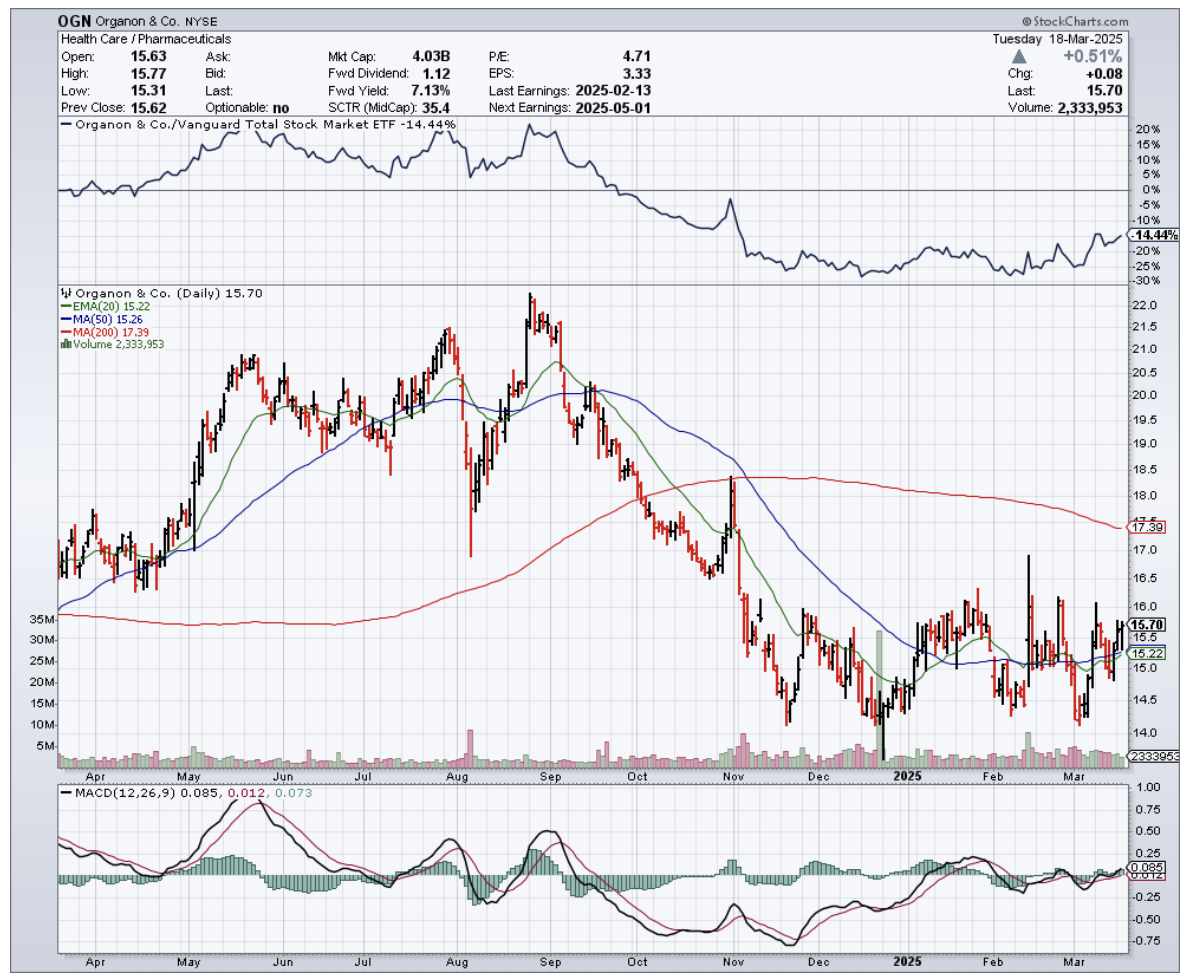
Mad Hedge Biotech and Healthcare Letter
May 23, 2023
Fiat Lux
Featured Trade:
(HUNTING FOR OPPORTUNITIES IN HEALTHCARE STOCKS)
(LLY), (NVO), (VTRS), (OGN), (MRK), (TEVA), (GI), (CNC), (PFE), (GILD), (AMGN)
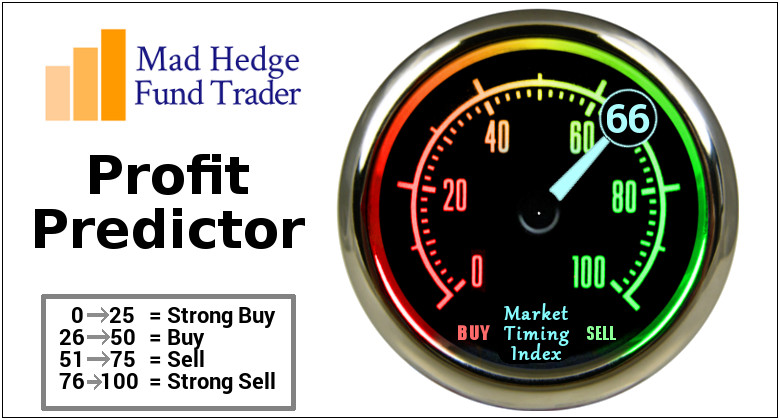
I've been riveted by the healthcare sector's most extravagant stocks lately.
Just look at Eli Lilly (LLY), with its jaw-dropping market value of $412 billion, making it the richest pure-play biopharma company ever. And right on its heels is Novo Nordisk (NVO), boasting a market value of $377 billion. It's enough to make your head spin.
But if you're on the hunt for value, these sky-high prices might leave you feeling a bit queasy. That's why I embarked on a mission to uncover some hidden gems in the healthcare sector.
Now, don't get me wrong. These stocks may be cheap for a reason, and it's crucial to exercise caution. When it comes to investment opportunities, it's essential to separate the diamonds in the rough from the fool's gold.
Enter Viatris (VTRS), a rising star in the generic drug manufacturing arena that has caught the attention of savvy investors seeking long-term holdings. But is it the real deal, or just another flash in the pan?
Viatris shows potential with solid revenue from branded generics like Lipitor, Viagra, and EpiPens. These household-name medicines have a lasting market demand. Plus, its generous 5.2% dividend yield surpasses the market average.
But here's the catch: Viatris is currently undervalued and has yet to prove its growth potential. Its stock price took a hit, and sales in the core generic and branded segments dipped. However, there's hope in the pipeline.
With a range of injectable generic medicines awaiting approval, Viatris could be at the forefront of the market.
By 2027, these programs could yield over $1 billion in annual revenue. While not a game-changer for the company's overall revenue, it sets the stage for future earnings growth.
At this stage, I don’t see Viatris as a slam-dunk investment. However, monitoring their strategic plan to reduce debt, improve efficiency, and drive growth is prudent. It's a work-in-progress worth monitoring for future opportunities.
Another company that caught my attention is Organon (OGN), a recent spinout from Merck (MRK) that focuses on women's health and biosimilars. This hidden gem trades at an attractive valuation of just 4.8 times earnings.
Organon & Co. is a pioneering developer and provider of prescription therapies and medical devices catering to contraception and fertility needs.
The female contraceptive market is projected to experience robust growth, with a compound annual growth rate (CAGR) of 8.5% from 2022 to 2027. Notably, Organon is among the top 5 major corporations addressing the demands in this market segment.
But that's not all.
Organon boasts a diverse portfolio that extends beyond women's health. They also offer biosimilar immunology products, two oncology treatments, hypertension therapies, respiratory solutions, dermatology products, non-opioid pain management pills, and cures for male pattern hair loss.
On its first day of official existence, June 3, 2021, Organon's management proudly announced a lineup of over 60 drug products to enhance female health, along with Merck's (MRK) former biosimilars portfolio.
The biosimilars market is projected to soar to $44.7 billion by 2026, showing an impressive CAGR of 23.5%.
As expected, the biosimilars arena has become a bustling hub with both established and emerging companies eagerly entering the space. For instance, Teva Pharmaceutical Industries Limited (TEVA) has high hopes for its biosimilar drug targeting arthritis treatment, expecting it to boost Teva's revenue significantly.
Organon has already witnessed promising revenue growth from its biosimilar drugs, with a remarkable 17% increase amounting to $116 million.
Several drug sales have experienced a surge of over 30% in the United States, Canada, and Brazil. Moreover, Organon's brands have shown strong performance in China and the Asia Pacific/Japan region.
Investing in women's health is not only a wise choice; it's a strategic move that can yield significant rewards for individual investors and portfolios. With Organon's innovative solutions, broad product portfolio, and forward-thinking approach, it stands out as a compelling opportunity in the market.
Now, let's take a look at some intriguing names that have found their way onto the list.
We have health insurance behemoth Cigna Group (GI), trading at a mere 9.9 times earnings, alongside the health insurer Centene (CNC) at 10.3 times earnings. Not to mention the presence of renowned drugmakers Pfizer (PFE), Gilead Sciences (GILD), and Amgen (AMGN) gracing this list of bargain stocks.
These seemingly cheap healthcare stocks warrant close attention for the savvy investor seeking hidden gems. Sure, the term "cheap" can sometimes be misleading, but within these underappreciated names lies the potential for hidden value waiting to be discovered.
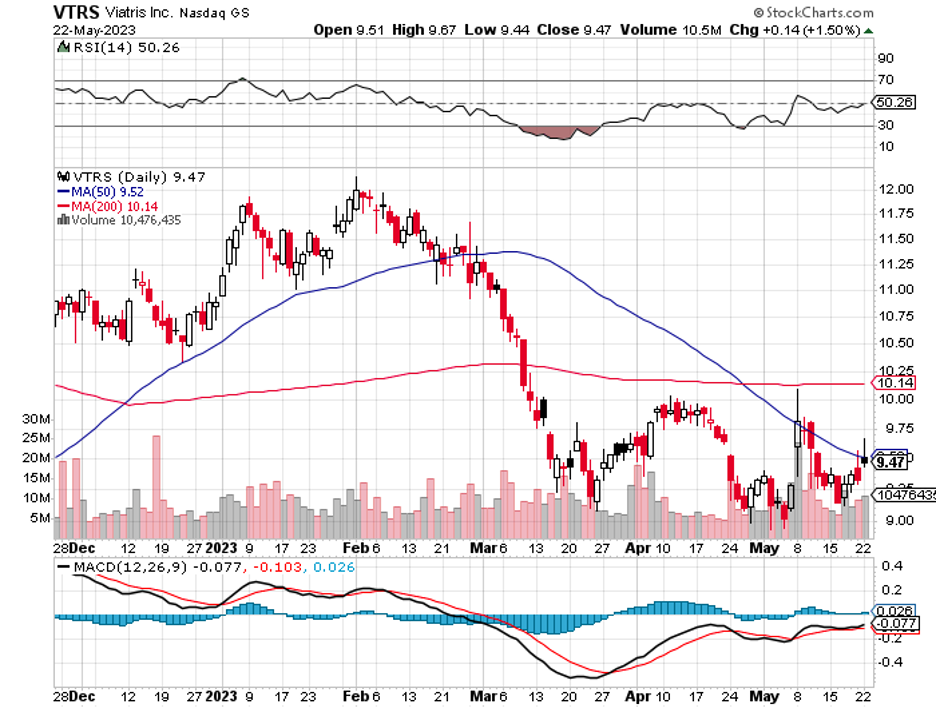
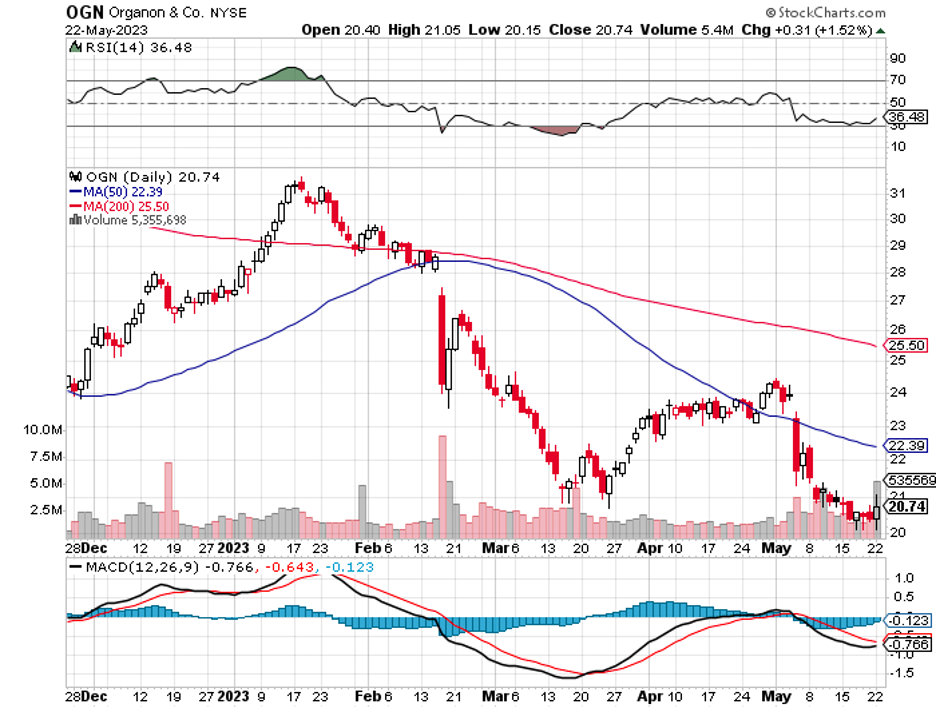
Mad Hedge Biotech and Healthcare Letter
October 20, 2022
Fiat Lux
Featured Trade:
(A CURE FOR A SICKENING MARKET)
(MRK), (OGN)
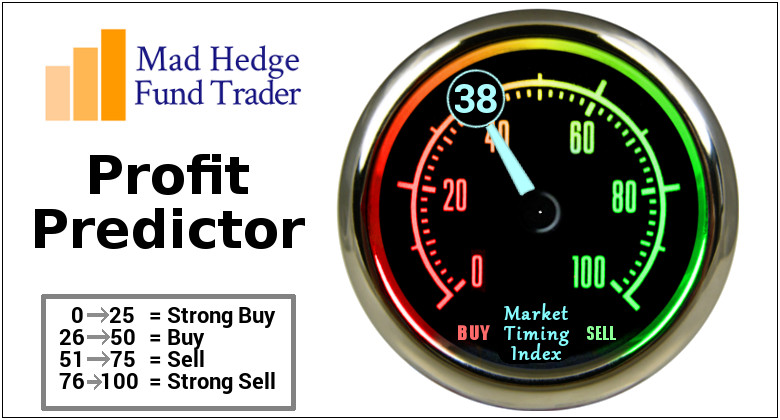
In this sickening market, it makes sense that the biotechnology and healthcare industry is proving to be a great hedge.
This sector has managed to remain one of the handful to post gains in 2022 amidst the seemingly never-ending barrage of negative news caused by the bear market, economic and political turmoil, and even health crises.
The criteria bring me to Merck (MRK), which has performed excellently this year.
Merck is a globally dominant biopharmaceutical company, standing the test of time, and having been in operation for more than 130 years.
It has consistently delivered stable results, showing off a 28% growth in sales in the second quarter of 2022. Among the names in its roster, the most profitable drug is cancer treatment Keytruda, which recorded a 30% year-over-year growth in sales during the same period.
Despite the already remarkable performance of Keytruda, this oncology medication has proven to be capable of targeting more than just lung cancer as it was recently given the green light for 6 additional indications.
In line with ensuring the company is not reliant on a single blockbuster drug, Merck has been aggressive in seeking potential high-selling candidates to add to its portfolio.
Recently, its $11.5 billion bet on Sotatercept, a heart medication, seems to have paid off as the company disclosed positive results from a Phase 3 trial focused on treating a condition called pulmonary arterial hypertension.
It was in 2021 when Merck bought Sotatercept as part of its agreement to acquire Accelerant Pharma. The goal was to find a drug to fill the anticipated revenue gap from the impending patent loss of Keytruda by 2030.
The strategy was high risk at that time because data on Sotatercept were limited on Phase 2 trial results. Nevertheless, Merck paid a significant sum to the company. That was reported as one of the biggest acquisitions of 2021.
Given the current data, the conservative estimate for Sotatercept sales is at $700 million annually. However, the established nature of the target market has some analysts pushing the forecast to potentially reach $4 billion by 2031.
However, unlike other biopharmaceutical companies that heavily depend on one or two blockbuster treatments, Merck has a strong lineup of high-margin products in the market.
Moreover, its pipeline candidates support its solid profitability and investment capital returns for several years. This becomes even more apparent with the spinoff of Organon (OGN) in 2021, where Merck retained a portfolio of drugs with strong patent protection.
It holds a moat-worthy portfolio of specialty treatments in various sectors, including oncology, immunology, cardiometabolic disease, rare diseases, and infections. It also has an extensive vaccine segment that targets HPV, pediatric conditions, shingles, and Hepatitis B.
In the past trailing 12 months, the company generated roughly $57 billion in revenue, with half coming from US sales and the rest internationally.
More importantly, Merck sports a notable 3.1% dividend yield that’s easily supported by a low 35% payout ratio. It reports a 9% five-year CAGR and has an impressive 11-year growth streak.
Throughout the years, Merck’s stock, underlying strategies, and growth model have demonstrated their resilience against macroeconomic headwinds, with the company’s core businesses firing on all cylinders.
It has one of the most solid balance sheets in the industry, which illustrates its financial flexibility to comfortably invest in promising R&D prospects and sustain its dividend at a solid pace.
Overall, Merck is an excellent choice for investors looking to deploy some capital but want to minimize exposure to volatility on top of the possibility of earning some extra dividend income.
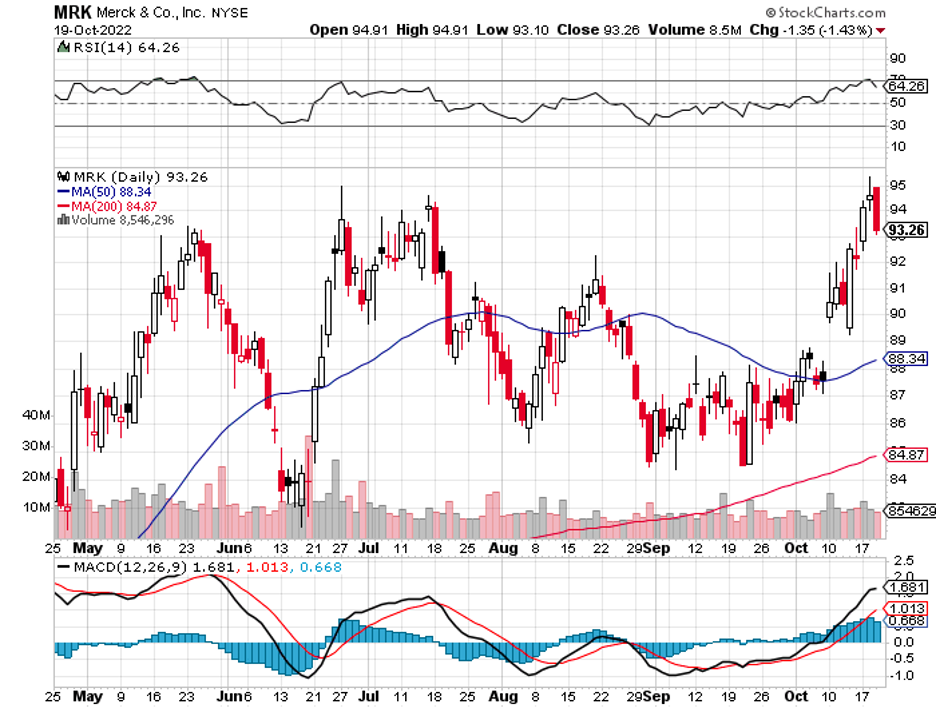
Mad Hedge Biotech and Healthcare Letter
June 16, 2022
Fiat Lux
Featured Trade:
(AN UNDERRATED LONG-TERM BIOPHARMA STOCK)
(OGN), (MRK), (PFE), (VTRS), (ABBV), (JNJ), (AMGN), (RHHBY), (BMY)
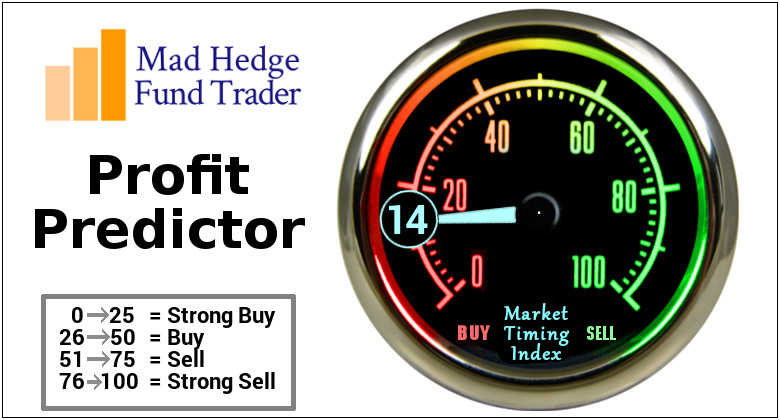
Six months into 2022, the markets are still in turmoil while highly valued stocks rapidly fall.
A way to cope with these is to search for safety and security among value-focused investments that are less at risk of sudden declines.
One business that remains profitable and is trading at a relatively affordable price, especially considering its future earnings multiples, is Organon (OGN).
Organon is a spinoff from Merck (MRK). It focuses on women’s health products, existing treatments, and biosimilars. It was launched roughly the same time Pfizer (PFE) launched its spinoff, Viatris (VTRS), in 2021.
While Organon has yet to become a superstar growth stock at the moment, it’s an excellent business to consider for a stable long-term investment.
So far, the company has managed to generate promising gross margins north of 60% and consistently proved to be profitable.
To date, Organon has over 60 treatments in its pipeline.
Thanks to strategic partnerships, Organon has become the biggest pharmaceutical company centered on women’s health.
Not only that, it has an extensive portfolio of biosimilars or biosimulators focusing on cardiovascular, dermatological, and respiratory conditions.
Meanwhile, Organon has one of the highest dividend yields among biopharma companies at 3.47%, with consistent dividend payments of $0.28 per share every quarter.
Organon’s biosimilar growth received a jumpstart from its agreement with Samsung Boepsis in 2013. The deal enables both companies to develop and market a number of biosimilar treatments focused on cancer and immunology.
Under this partnership, Organon has been granted exclusive license to manufacture, test clinically, and market inflammatory treatments like AbbVie’s (ABBV) top-selling Humira, Johnson & Johnson’s (JNJ) blockbuster Remicade, and Amgen’s (AMGN) moneymaking treatment Enbrel, as well as oncology therapies such as Roche’s (RHHBY) promising growth drivers Avastin and Herceptin.
These catapulted Organon as the leader in the fast-expanding healthcare field, where several lucrative drugs will lose their patent exclusivity before 2030.
Riding this momentum, Organon plans to expand its portfolio of biosimilars to cover more therapeutic fields like neuroscience, diabetes, and even ophthalmology.
To boost its portfolio, Organon has been collaborating with Shanghai’s Henlius Biotech to work on more biosimilars.
The Merck spinoff has agreed to pay $73 million upfront in addition to $30 million in milestone payments for the development of Pertuzumab, a biosimilar for Roche’s breast cancer treatment Perjeta, and Denosumab, a biosimilar of Amgen’s osteoporosis drug Prolia. Another Amgen drug, bone cancer treatment Xgeva, is included in the collaboration agreement.
For context, Amgen reported $873 million in sales for Prolia and $545 million for Xgeva in 2021, while Roche raked in $4 billion from Perjeta.
If this partnership works out, Organon and Henlius plan to move forward with a biosimilar to Bristol Myers Squibb’s (BMY) cancer drug Yervoy and its best-selling Opdivo.
While these are all exciting, it may still take some time for the biosimilars to be released to the market. Among them, the Prolia biosimilar has the most apparent timeline, potentially launching the product by 2024.
Although Organon has yet to make a splash in the biopharmaceutical market, the company holds impressive potential. So far this year, the stock has been up 15%—a performance that’s better than the S&P 500 that recorded 4% in losses over the same period.
More than that, its price is heavily discounted these days, offering investors an extra incentive to seize the opportunity to buy shares of this relatively new company in the healthcare sector.
It also has consistent revenue growth and a promising pipeline of diverse candidates with the potential to expand the company’s portfolio.
Taking all these into consideration makes Organon an underrated buy at the moment and a great candidate for long-term investors.
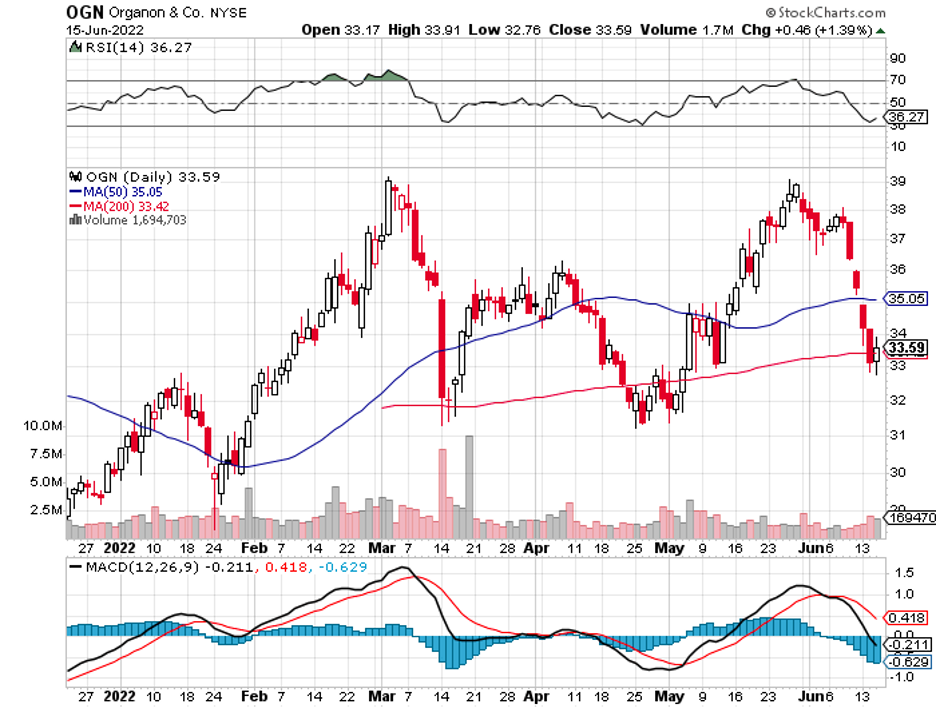
Mad Hedge Biotech and Healthcare Letter
May 19, 2022
Fiat Lux
Featured Trade:
(A RELIABLE STOCK THAT CAN WITHSTAND ANY GLOBAL SHOCKWAVE)
(JNJ), (PFE), (VTRS), (MRK), (OGN), (ABBV), (ABT), (NVO)
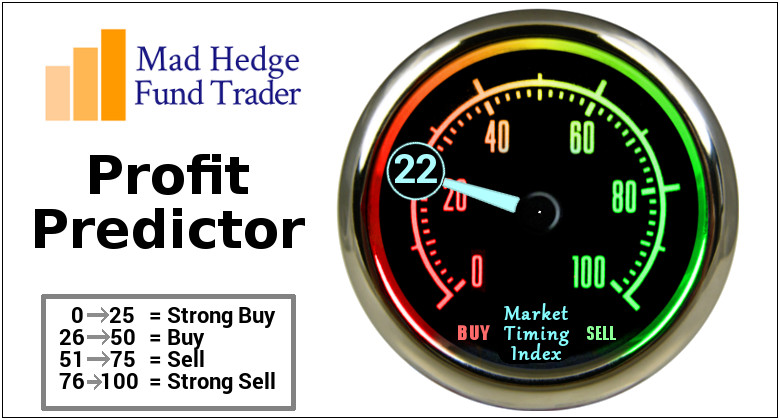
Investing is a long-term bet that requires patience and a strong risk appetite to enjoy eventual big wins.
In a world filled with uncertainties and gambles in the ever-evolving stock market trends, risk-averse investors are on the lookout for secure and stable options.
After all, who wouldn’t want to invest their hard-earned cash in a stock that can survive even the most intense macroeconomic shocks?
The name that easily fits these criteria in the biotechnology and healthcare sector is Johnson & Johnson (JNJ).
Reviewing JNJ’s five-year price movements from 2017 until 2022, a steady bullish trend of roughly 46% growth can be seen.
This trend has continued amid the slowdowns, with the stock delivering consistent growth and recovery despite serious dips.
In early 2020, when the COVID-19 outbreak wreaked havoc on the global economy, JNJ tanked along with other stocks. However, the company steadily showed signs of recovery mere weeks following the outbreak.
By 2021, JNJ managed to record a substantial increase of 11.4%. More importantly, it was able to sustain that trend throughout the year.
In March 2022, when the Ukraine-Russia crisis disrupted the economy, several businesses in the industry once again crashed due to supply chain and logistical issues. Amid these disruptions, JNJ still managed to stay on its growth path and develop contingencies to protect its assets.
Widely known as a global healthcare titan, JNJ holds a market capitalization that is hovering close to roughly half a trillion dollars.
As the parent company of the top-rated brands like Benadryl, Listerine, and Neutrogena, JNJ’s market operations are trifurcated into three main segments: MedTech, Pharmaceutical, and Consumer Health.
In November 2021, the company disclosed its plans to spin off its consumer arm into a separate publicly-traded company.
Similar to the move of Pfizer (PFE) with its Viatris (VTRS) spinoff and Merck (MRK) with Organon (OGN), JNJ’s goal is to reclassify a number of its international OTC drugs from its Consumer Health branch to form part of the pipeline of the new spinoff company.
Needless to say, the company’s notably diversified portfolio provides its with a competitive advantage in this highly volatile market.
Meanwhile, its other two segments are also contributing to JNJ’s growth. Its Pharmaceutical branch recorded a 6.3% increase in revenue in the first quarter of 2022, while its MedTech segment grew by 5.9%.
In total, JNJ’s sales for the first quarter of 2022 rose by 5% to reach $23.4 billion. This also boosted the company’s earnings per share to $2.67.
Riding the momentum of its strong first-quarter showing this year, JNJ once again demonstrated why it is hailed as a Dividend King.
The company hiked its quarterly dividend by 6.6% to $1.13 per share, making this the 60th consecutive annual dividend increase.
Considering that the company has been paying out dividends since 1963, this latest increase is indicative of how safe JNJ is for investors who want to multiply their cash while earning a regular income via dividends.
Moreover, JNJ is a clear frontrunner in the healthcare world and continues to work on innovative solutions to keep it ahead of its competitors.
Taking a closer look at the broader competitive field of healthcare industry players that are considered similarly sized, like AbbVie (ABBV), Abbott Laboratories (ABT), and Novo Nordisk (NVO), JNJ has the most significant market capitalization.
In this aspect, the company is the largest among its direct rivals. Therefore, it essentially reinforces its capacity to raise finances.
Given its perpetual bullish climb since its trade initiation back in 1982 and its addition to the Dow Jones Industrial Average (DJI), JNJ stock has been long known to hold strong credibility.
Actually, JNJ and Microsoft (MSFT) are the only two American companies with an AAA credit rating, a grade above the United States government itself.
This means that JNJ has such a strong sense of certainty in debt repayment that it holds a lower probability of default than the US government—an entity allowed by law to print money.
Overall, JNJ has proven to be an excellent option for risk-averse investors searching for growth and profitability.
It has strong financial fundamentals and a commanding market position, making it a highly stable and secure investment.
Moreover, its diverse portfolio minimizes the risk exposure of the company. All these make JNJ a great buy. Hence, it would be a wise move to buy the dip.
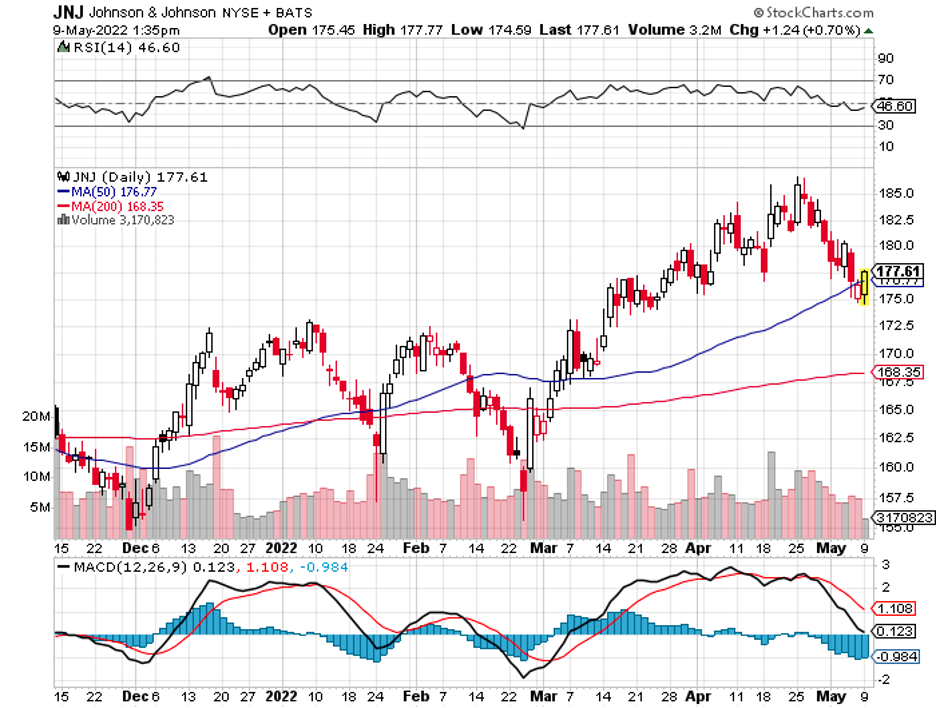
Legal Disclaimer
There is a very high degree of risk involved in trading. Past results are not indicative of future returns. MadHedgeFundTrader.com and all individuals affiliated with this site assume no responsibilities for your trading and investment results. The indicators, strategies, columns, articles and all other features are for educational purposes only and should not be construed as investment advice. Information for futures trading observations are obtained from sources believed to be reliable, but we do not warrant its completeness or accuracy, or warrant any results from the use of the information. Your use of the trading observations is entirely at your own risk and it is your sole responsibility to evaluate the accuracy, completeness and usefulness of the information. You must assess the risk of any trade with your broker and make your own independent decisions regarding any securities mentioned herein. Affiliates of MadHedgeFundTrader.com may have a position or effect transactions in the securities described herein (or options thereon) and/or otherwise employ trading strategies that may be consistent or inconsistent with the provided strategies.
This site uses cookies. By continuing to browse the site, you are agreeing to our use of cookies.
OKLearn moreWe may request cookies to be set on your device. We use cookies to let us know when you visit our websites, how you interact with us, to enrich your user experience, and to customize your relationship with our website.
Click on the different category headings to find out more. You can also change some of your preferences. Note that blocking some types of cookies may impact your experience on our websites and the services we are able to offer.
These cookies are strictly necessary to provide you with services available through our website and to use some of its features.
Because these cookies are strictly necessary to deliver the website, refuseing them will have impact how our site functions. You always can block or delete cookies by changing your browser settings and force blocking all cookies on this website. But this will always prompt you to accept/refuse cookies when revisiting our site.
We fully respect if you want to refuse cookies but to avoid asking you again and again kindly allow us to store a cookie for that. You are free to opt out any time or opt in for other cookies to get a better experience. If you refuse cookies we will remove all set cookies in our domain.
We provide you with a list of stored cookies on your computer in our domain so you can check what we stored. Due to security reasons we are not able to show or modify cookies from other domains. You can check these in your browser security settings.
These cookies collect information that is used either in aggregate form to help us understand how our website is being used or how effective our marketing campaigns are, or to help us customize our website and application for you in order to enhance your experience.
If you do not want that we track your visist to our site you can disable tracking in your browser here:
We also use different external services like Google Webfonts, Google Maps, and external Video providers. Since these providers may collect personal data like your IP address we allow you to block them here. Please be aware that this might heavily reduce the functionality and appearance of our site. Changes will take effect once you reload the page.
Google Webfont Settings:
Google Map Settings:
Vimeo and Youtube video embeds:
